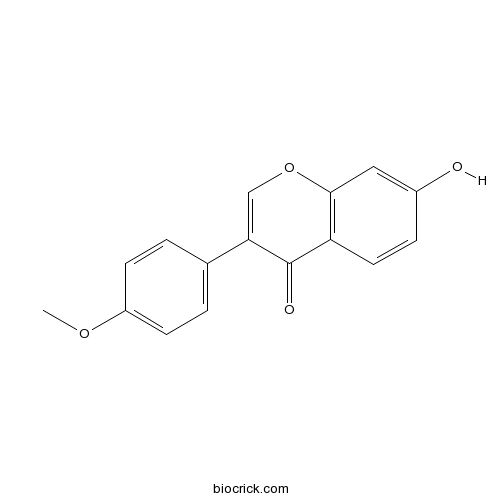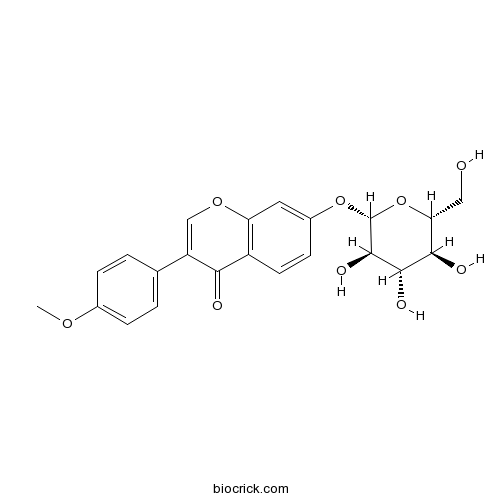Ammopiptanthus mongolicus
Ammopiptanthus mongolicus
1. The products in our compound library are selected from thousands of unique natural products; 2. It has the characteristics of diverse structure, diverse sources and wide coverage of activities; 3. Provide information on the activity of products from major journals, patents and research reports around the world, providing theoretical direction and research basis for further research and screening; 4. Free combination according to the type, source, target and disease of natural product; 5. The compound powder is placed in a covered tube and then discharged into a 10 x 10 cryostat; 6. Transport in ice pack or dry ice pack. Please store it at -20 °C as soon as possible after receiving the product, and use it as soon as possible after opening.
Natural products/compounds from Ammopiptanthus mongolicus
- Cat.No. Product Name CAS Number COA
-
BCN1061
Formononetin485-72-3
Instructions

-
BCN5926
Ononin486-62-4
Instructions

AmDREB2C, from Ammopiptanthus mongolicus, enhances abiotic stress tolerance and regulates fatty acid composition in transgenic Arabidopsis.[Pubmed: 30096686]
Dehydration-responsive element-binding (DREB) transcription factors (TFs) play a vital role in plant response to abiotic stresses. However, little is known about DREB TFs in plants adapted to harsh environments and in the formation of polyunsaturated fatty acids (PUFAs), a major membrane component closely associated with plant stress tolerance. Here, we characterized AmDREB2C in Ammopiptanthus mongolicus (Maxim. ex kom.) Cheng F., a desert evergreen broadleaf shrub with a high tolerance to harsh environments. AmDREB2C encodes a canonical DREB2-type TF, and the protein was localized in the nucleus. AmDREB2C had the highest expression levels in leaves of naturally growing shrubs in the wild during the winter season of a year of sampling. The expression was also induced by cold, heat and drought stresses in laboratory-cultured seedlings. Moreover, AmDREB2C was most abundantly expressed in young leaves and immature seeds rather than other tissues of the shrubs. Constitutive expression of AmDREB2C in Arabidopsis enhanced freezing, heat and drought tolerances of the transgenic plants, likely through inducing the expression of important stress-responsive genes. The transgene also increased the level of linolenic acid (C18:3), a major PUFA in most plant species, in leaves and seeds of the transgenic plants. Correspondingly, the transcription of FAD3, FAD7 and FAD8, three genes encoding fatty acid desaturases (FADs) responsible for the production of C18:3, showed a differential up-regulation in these two organs. This study provides new insight into the underlying molecular mechanisms of A. mongolicus' ability to endure harsh environments and DREB TF regulation of fatty acid desaturation.
Dark septate endophytes isolated from a xerophyte plant promote the growth of Ammopiptanthus mongolicus under drought condition.[Pubmed: 29785041]
Dark septate endophytes (DSE) may facilitate plant growth and stress tolerance in stressful ecosystems. However, little is known about the response of plants to non-host DSE fungi isolated from other plants, especially under drought condition. This study aimed to seek and apply non-host DSE to evaluate their growth promoting effects in a desert species, Ammopiptanthus mongolicus, under drought condition. Nine DSE strains isolated from a super-xerophytic shrub, Gymnocarpos przewalskii, were identified and used as the non-host DSE. And DSE colonization rate (30-35%) and species composition in the roots of G. przewalskii were first reported. The inoculation results showed that all DSE strains were effective colonizers and formed a strain-dependent symbiosis with A. mongolicus. Specifically, one Darksidea strain, Knufia sp., and Leptosphaeria sp. increased the total biomass of A. mongolicus compared to non-inoculated plants. Two Paraconiothyrium strains, Phialophora sp., and Embellisia chlamydospora exhibited significantly positive effects on plant branch number, potassium and calcium content. Two Paraconiothyrium and Darksidea strains particularly decreased plant biomass or element content. As A. mongolicus plays important roles in fixing moving sand and delay desertification, the ability of certain DSE strains to promote desert plant growth indicates their potential use for vegetation recovery in arid environments.
Functional analysis of a type 2C protein phosphatase gene from Ammopiptanthus mongolicus.[Pubmed: 29427736]
In Arabidopsis and certain other plant species, the type 2C protein phosphatases (PP2Cs) of the clade A class have been demonstrated to act as negative regulators in ABA-induced stress responses, such as stomatal closure. The present study reports the identification of a PP2C ortholog from the ancient desert shrub Ammopiptanthus mongolicus (Maxim.) Cheng f. (AmPP2C), which is functionally conserved over its counterparts reported from other plant species. AmPP2C was primarily expressed in leaves, with strong transcriptional accumulation being observed in the guard cells. The expression of AmPP2C was induced in response to PEG or ABA treatments, implying the potential involvement in ABA-induced stress responses. The GFP-tagging observation revealed that AmPP2C was predominantly localized to the nuclei and partly to the cytoplasm. Furthermore, BiFC assays demonstrated an interaction between AmPP2C and the typical protein kinase SnRK2.6 (AmOST1). Overexpression of AmPP2C in Arabidopsis significantly overcame the inhibition of seed germination by ABA. The transgenic Arabidopsis lines exhibited larger stomatal apertures and significantly reduced sensitivity to ABA-induced stomatal closure, which subsequently led to greater water loss and decreased biomass under PEG-simulated drought stress treatments. Under limited nitrogen or potassium supplements, plants overexpressing AmPP2C obtained a superior capability of nitrogen (N) and potassium (K) acquisition in the green parts. Therefore, the impairment of ABA-induced stomatal closure rendered by the function of PP2C helped to identify a potential survival strategy in plants suffering persistent drought stress via the maintenance of the necessary mineral nutrient acquisition driven by transpirational solute flow.
An unusual strategy of stomatal control in the desert shrub Ammopiptanthus mongolicus.[Pubmed: 29413627]
None
Quantitative Phosphoproteomic Analysis Provides Insight into the Response to Short-Term Drought Stress in Ammopiptanthus mongolicus Roots.[Pubmed: 29039783]
None
Kribbella deserti sp. nov., isolated from rhizosphere soil of Ammopiptanthus mongolicus.[Pubmed: 27902295]
None
Transcriptome analysis of potential simple sequence repeat markers in Ammopiptanthus mongolicus.[Pubmed: 27706655]
Ammopiptanthus mongolicus, an evergreen broadleaf legume shrub, can survive under conditions of high and low temperature, extreme salinity, and drought. This attribute makes it an ideal model for studying mechanisms of stress tolerance in plants. However, simple sequence repeat (SSR) resources for this species are insufficient in public databases. In this study, a total of 44,959 unigenes identified from the A. mongolicus transcriptome were used for SSR analysis by MIcroSAtellite (MISA). A total of 13,859 SSRs were found to be distributed within 10,409 unigenes, with an average length of 15 bp and an average density of one SSR per 4.4 kb. There were 222 different motif types in the A. mongolicus transcriptome, and mononucleotide repeats represented the main type, accounting for 44.2% of all SSRs. The (A/T)n repeat was the most frequent motif, accounting for 42.37% of all SSRs. We also performed Gene Ontology functional analysis, Kyoto Encyclopedia of Genes and Genomes database pathway analysis, and eggNOG analysis, and identified 6157, 2301, and 9845 unigenes containing SSRs in these three databases, respectively. The functional categorization of A. mongolicus unigenes containing SSRs revealed that these unigenes represent many transcribed genes with different functions. These data provide sequence information that may be used to improve molecular-assisted markers for the study A. mongolicus genetic diversity.
Identification of drought-responsive microRNAs and their targets in Ammopiptanthus mongolicus by using high-throughput sequencing.[Pubmed: 27698373]
MicroRNAs (miRNAs) regulate target gene expression to modulate plant growth, development, and biotic and abiotic stress response at the post-transcriptional level. Ammopiptanthus mongolicus, an ecologically important desert plant, is increasingly used as a model for studying stress tolerance in plants. The miRNA-mediated gene regulatory network might remarkably contribute to the high stress tolerance of A. mongolicus. However, a genome-wide identification of miRNAs and their targets is still lacking in A. mongolicus. In this study, 170 conserved and 156 non-conserved miRNAs were identified in A. mongolicus. We experimentally identified 298 miRNA-target pairs from the degradome data. Quantitative real-time polymerase chain reaction analyses identified 28 drought-responsive miRNAs in leaves and 15 in roots. Some characteristics of the miRNA-mediated regulatory network were found in A. mongolicus. Multiple miRNAs, including 2 newly identified non-conserved miRNAs, miR-P11 and miR-P14, generated from the precursors of miR169, were found to be involved in drought stress response. Further, miR2118 and miR858 participated in drought stress response by up-regulating OZF1 gene and certain MYB genes that were involved in the regulation of flavonol biosynthesis in A. mongolicus. The findings of this study might provide new insights for understanding the functions of miRNA in stress response in plants.


